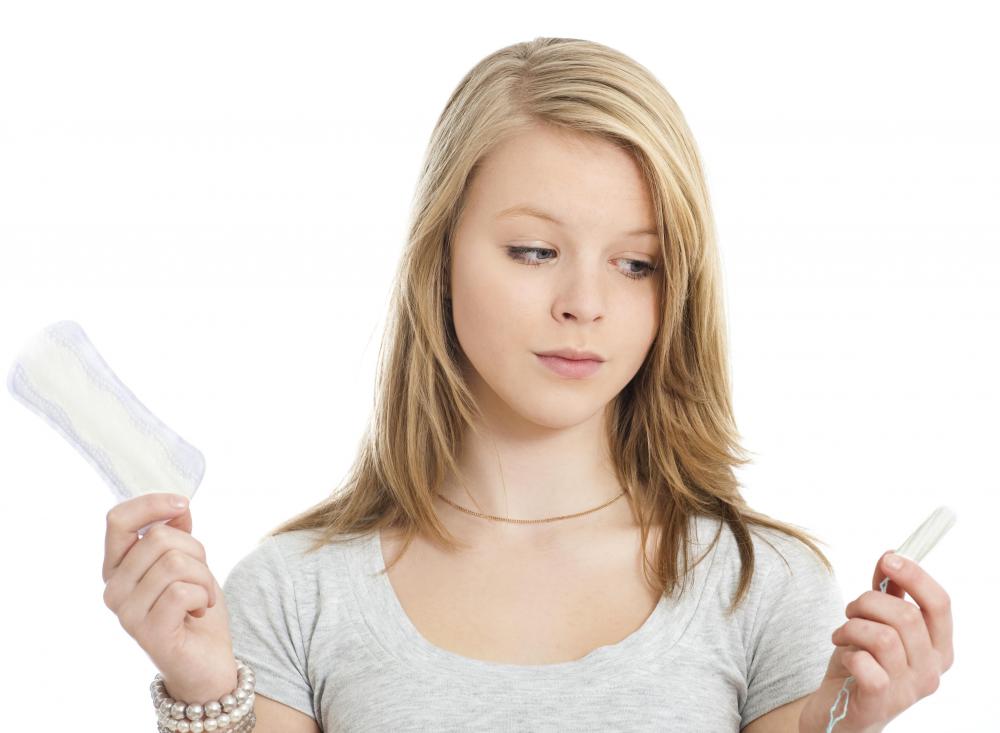At WiseGEEK, we're committed to delivering accurate, trustworthy information. Our expert-authored content is rigorously fact-checked and sourced from credible authorities. Discover how we uphold the highest standards in providing you with reliable knowledge.
What is a Tampon?
A tampon is a product made of materials that are highly absorbent, and is placed in the vagina during menstruation to soak up blood before it stains underwear or other clothing. Sometimes tampons also refer to other absorbent material placed in wounds to stop bleeding, but this is less common. Tampons have been in use for a long time, and now are available in many varieties.
There is record of using materials in the vagina during menstruation thousands of years ago in ancient Egypt, but the modern tampon got its start in the early 20th century. Two styles of tampons, made of cotton-like material, began to gain popularity during this time. One was the digital type, which is inserted into the vagina with the fingers only. Applicator versions of the tampon, which American women in particular prefer, were developed by the early 1930s. Tampons competed with the other feminine products, like sanitary napkins, and became more popular for some women.

Today, numerous styles of the tampon exist and they are aggressively marketed. Women who use this feminine product choose them because they offer the freedom to engage in activities that sanitary pads cannot, though alternatives like insertable menstrual cups might offer a similar freedom. For example, wearing tampons makes it possible to do things like wear a swimsuit and engage in water activities, which is much more difficult to do with most maxi pads. They’re also easy to insert, and easy to remove because they feature a string that sits outside the vagina which is pulled to bring the tampon out. Most tampons are also flushable, though this may not be the case if waste goes to a septic system.

Two types of the tampon are generally available. Some offer absorption by increasing in length as moisture comes into contact with them. Others expand outward in a parachute fashion. Both types are effective, but they also come in different sizes, and tampon size does need to be considered. Smaller sizes are generally designed for smaller built women and/or for low flow days, while larger sizes may offer greater absorption and be more effective for times when menstruation is heaviest. Some companies sell boxes of tampons in numerous sizes to accommodate for days when flow is heavier and for days when it is lighter.
Tampons are available in many different applicators, depending on brand. The traditional applicator is a simple cardboard tube, which is flushable and biodegradable. Others may be plastic and designed for more comfortable insertion.

There are health concerns about tampons, and the most significant of these is the risk of toxic shock syndrome. This risk is minimal, provided tampons are not worn for more than six to eight hours. Failure to remove them, or forgetting a tampon is in place and adding another risks this very serious illness. Additionally, tampons are not acceptable for use for other forms of vaginal bleeding, such as after childbirth, miscarriage, or abortion. In these instances, inserting anything into the vagina can risk infection.
AS FEATURED ON:
AS FEATURED ON:















Discussion Comments
I've heard some scary things about tampons like how they lead to infections and toxic shock syndrome. A friend of mine actually developed a kidney infection because of a forgotten tampon. She simply forgot that she had one in and the tampon became infected and the infection spread. She was in the hospital for a while for treatment and she has vowed never to use tampons again.
@burcinc-- Don't worry, you will be fine. Just follow the directions on the box and select the right sized tampon. You may want to buy a personal lubricant because it will make it easier to insert the tampon. Just apply some of the lubricant on the tampon before inserting. Make sure that it is inserted as far as it needs to be. The string should remain accessible but you should not feel the tampon if it is properly inserted.
I think that tampons are very easy to use and they definitely make life easier. You can wear whatever you want with them and exercise as well. Just make sure to remove it and insert a fresh one about every three hours. This will prevent infections.
I've never used a tampon before. I'm going on vacation next week and I suspect that I will have my period during the trip. I really want to wear a swimsuit and spend time on the beach so I'm considering using a tampon. I'm a bit anxious though. I hope it won't be difficult to insert and I hope there won't be any accidents.
Does anyone here have any suggestions for first time tampon use?
Post your comments